| |
All pictures are copyright of Jaap de Roode. |
|
| |
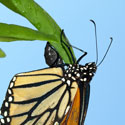 |
A female monarch butterfly laying eggs on the medicinal milkweed Asclepias curassavica (tropical milkweed). |
|
 |
A healthy female monarch butterfly nectaring on Lantana. |
|
| |
|
|
|
|
|
|
| |
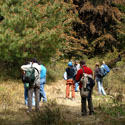 |
Fieldwork in a Mexican monarch overwintering site: note the trees covered in monarch butterfies. |
|
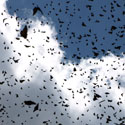 |
Monarchs take to the sky in Mexico. |
|
| |
|
|
|
|
|
|
| |
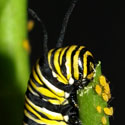 |
Monarch butterfly caterpillars regularly have to share their milkweed food plants with oleander aphids (Aphis nerii). |
|
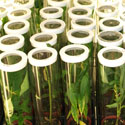 |
In the lab, monarchs are reared in plastic tubes with milkweed plants. |
|
| |
|
|
|
|
|
|
| |
 |
Eleanore and Rachel setting up a big lab experiment. |
|
 |
When monarch butterflies are heavily infected with the protozoan parasite Ophryocystis elektroscirrha, they can sometimes get stuck to their chrysalis. This means death for both monarch and parasite. |
|
| |
|
|
|
|
|
|
| |
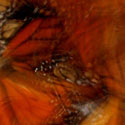 |
Wild-caught butterflies at the Pismo Beach overwintering site in California produce a fluttering piece of art. |
|
 |
Carlos and Rachel sample milkweed leaves for chemical analysis. |
|
| |
|
|
|
|
|
|
| |
 |
A first instar monarch larva feeding on Asclepias incarnata (swamp milkweed). |
|
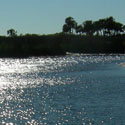 |
Monarchs migrating from eastern North America to Mexico stop over at the St Marks Wildlife Refuge. |
|
| |
|
|
|
|
|
|
| |
 |
Jaap, Rachel, Carlos, Eleanore and Mike on fieldwork in Mexico. |
|
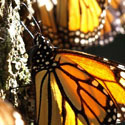 |
Monarch butterflies catching the sun on an oyamel tree in a Mexican overwintering site. |
|
| |
|
|
|
|
|
|
| |
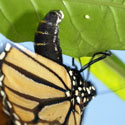 |
A female monarch butterfly laying eggs on the medicinal milkweed Asclepias curassavica (tropical milkweed). |
|
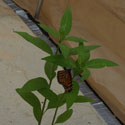 |
In the lab, oviposition preferences of monarchs are tested by placing them in a cage with two milkweed plants. |
|
| |
|
|
|
|
|
|
| |
 |
In western North America, monarchs migrate to groves along the Californian Pacific coast, such as in Pismo Beach. |
|
 |
A second and fifth instar monarch larva share this tropical milkweed with oleander aphids. |
|
| |
|
|
|
|
|
|
| |
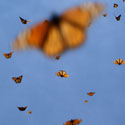 |
Monarchs take to the sky in Mexico. |
|
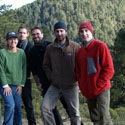 |
Getting together with Sonia Altizer's lab to do fieldwork in Mexico. |
|
| |
|
|
|
|
|
|
| |
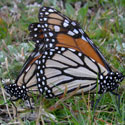 |
Monarchs mating in the early spring in Mexico. |
|
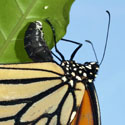 |
A female monarch butterfly laying eggs on the medicinal milkweed Asclepias curassavica (tropical milkweed). |
|
| |
|
|
|
|
|
|
| |
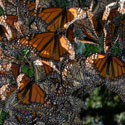 |
Monarchs cluster together for warmth in a Mexican overwintering site. |
|
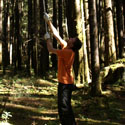 |
Jaap collecting monarch butterflies from the trees in Mexico. |
|
| |
|
|
|
|
|
|
| |
 |
Rachel and Mike surrounded by Mexican butterflies. |
|
 |
A female monarch butterfly laying eggs on the medicinal milkweed Asclepias curassavica. |
|
| |
|
|
|
|
|
|
| |
 |
A fifth instar monarch caterpillar on Asclepias curassavica (tropical milkweed). |
|
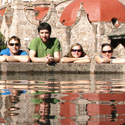 |
Visiting the Mexican city of Morelia after fieldwork. |
|
| |
|
|
|
|
|
|
| |
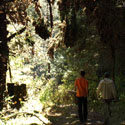 |
Monarchs hang in clusters from the trees in Mexico. |
|
 |
When monarch butterflies are heavily infected with the protozoan parasite Ophryocystis elektroscirrha, they can sometimes get stuck to their chrysalis. In this case, a paper wasp takes advantage of the situation. |
|
| |
|
|
|
|
|
|
| |
 |
A healthy monarch butterfly about to emerge from its chrysalis. |
|
 |
Carlos surrounded by monarch butterflies in an oyamel fir tree forest in Mexico. |
|
| |
|
|
|
|
|
|
| |
 |
In the lab, caterpillars are infected with parasites by feeding them small disks of milkweed with parasites in petri dishes. |
|
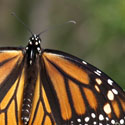 |
A female monarch butterfly migrant resting in St Marks, Florida, on her way from North America to Mexico. |
|
| |
|
|
|
|
|
|
| |
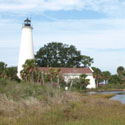 |
The lighthouse in St Marks, at the stopover for monarchs on their migration from North America to Mexico. |
|
 |
Rachel, Amanda and Thierry at the St Marks Monarch Butterfly Festival 2009. |
|
| |
|
|
|
|
|
|
| |
|
|
|
|
|
|
| |
|
|
